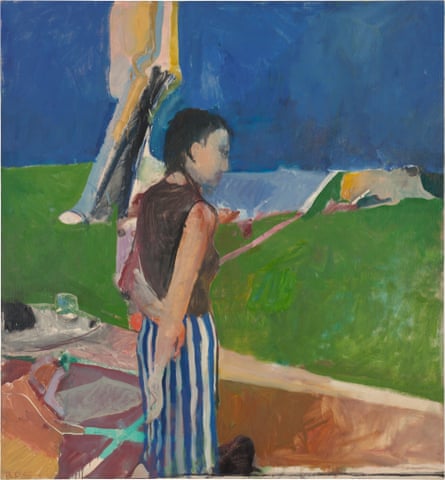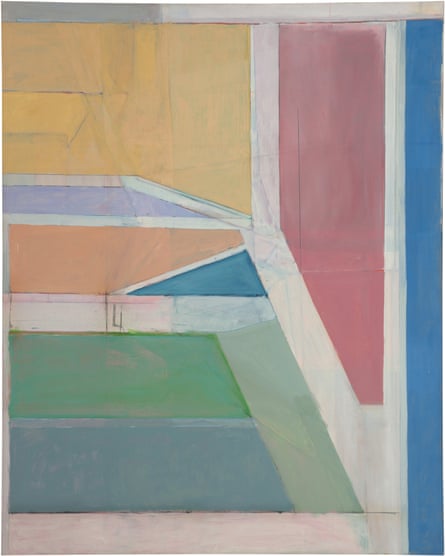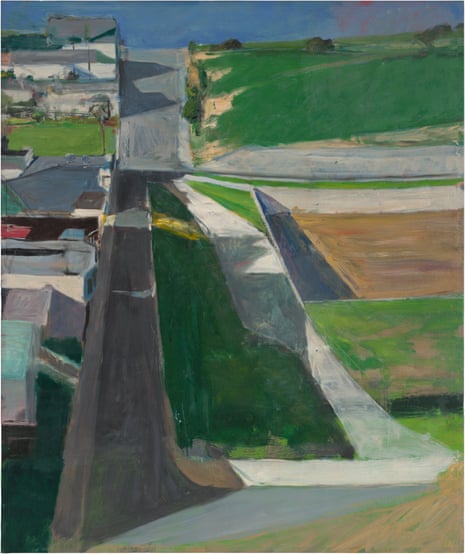In 1959, a telling photograph was taken of Richard Diebenkorn, one of the greatest and most doggedly independent American painters of the 20th century, and certainly the best still to remain practically unknown in the UK, though a retrospective at the Royal Academy is likely to change that. He is standing by a window in the studio he built in the backyard of his house in Berkeley, California, dressed in a tan shirt more or less neatly tucked into belted chinos, one hand in his pocket, a cigarette held at the midline of his chest. His head is slightly cocked and though he is still, he conveys a coiled restlessness that is near to agitation.
In front of him is a low table covered with the customary paraphernalia of brushes, soiled rags, tins and squeezed tubes of oil paint. Behind is a large canvas of a room in which a man and woman sit on chairs, facing one another. Even at this distance, this dual remove, you can clearly see the brushstrokes on the tomato-coloured carpet, the grey wall with its two bright apertures of sky: a motionful scumble hinged with white.
This is Diebenkorn caught halfway through the second of his three great acts: his reinventions of himself first as an abstract expressionist and then, unfashionably, as a figurative painter. Seven years on, relocated to Santa Monica, he returned to abstraction once again with the sublimely luminous Ocean Park series, their structure inspired by the lighted grid of windows. But no matter which stylistic constraints he was labouring under, what he was trying to achieve in these roving works was “a feeling of strength in reserve – tension beneath calm”.
Diebenkorn was born in Portland, Oregon, that rainy city, in 1922. At the age of two, he moved to San Francisco, another place of murky light. He started drawing when he was young, hypnotised by a set of postcards of the Bayeux Tapestries his grandmother had given him. Decades later, he said what had fascinated him was their composition: the three discrete narrative bands set horizontally, the battle scenes and fallen men running separate but parallel; a technique he would make use of in his later abstractions.

He was at Stanford, studying liberal arts, when Pearl Harbor was bombed. He joined the marine corps soon after and was called up in 1943. That June, he married his girlfriend Phyllis, a fellow student, and left for officer training. War could have derailed his aspirations, but instead it provided a perspective-broadening art education of its own. Stationed in Virginia, he was able to travel to museums, soaking up the influence of the impressionists: Cézanne, Bonnard and especially Matisse, with their pliant, luxuriant colour.
In 1945 he was assigned to the photographic division and posted to Hawaii as a cartographer. But while he enjoyed working alongside a “jolly group” that included Walt Disney-trained animators, he found he lacked the requisite precision: his maps were always developing blots or bubbles. Anathema to the mapmaker, errors and mistakes would play a significant role in his own work, as would the cartographer’s imperative of capturing the world as it appears from above. Years later, he said: “One thing I know has influenced me a lot is looking at landscape from the air … Of course, the Earth’s skin itself had ‘presence’ – I mean, it was all like a flat design – and everything was usually in the form of an irregular grid.”
Irregular grids soon migrated into his paintings. In 1950, after the war and a spell in California, Diebenkorn went with his young family (a son, Christopher, and a daughter, Gretchen) to Albuquerque, where he was able to begin an MA at the University of New Mexico, thanks to the GI bill, the same mechanism for converting soldiers back to citizens that got the poet Frank O’Hara to Harvard.
His Albuquerque paintings translate this dry, richly pigmented landscape into complex zones of pink and orange, tan and mauve, the colours alive on the canvas, suggesting canyons and escarpments without quite reconciling into concrete forms.
Abstraction was in its ascendance in the 1950s, though its chieftains, among them Mark Rothko, Jackson Pollock and Diebenkorn’s own favourite, the former house painter Willem de Kooning, were based on the east coast. So dominant was the rejection of the figure that when in 1970 the formerly abstract painter Philip Guston introduced representation into his work – a frightening, cartoonish cavalcade of things that included boots, Klansmen, bricks and cigarettes – he was met with incomprehension and fury by the critics.
This isn’t to say that there hadn’t been figurative painters moving among the abstract expressionists, including Jane Freilicher and Fairfield Porter. But what’s striking about Diebenkorn’s rejection of what he felt had become “a stylistic straitjacket” is that his work retained its extraordinarily expressive way of handling paint, as if the objects, buildings and people were arising organically, spontaneously from his magnificent colourfields. Take 1963’s Knife and Glass, where the solid presence of a painter’s knife, its tip dipped with white, is not so much set against as within a wall of cream touched with blue, in which every traction line and twist of the brush is as powerfully visible as ploughmarks through soil.

The shift took place in 1954, following a move to Berkeley. Diebenkorn was always responsive to location; a sensitivity so acute that he was unsettled if the cigarette butts on his studio floor were cleared without his permission. The subjects of his figurative period – abstracted cityscapes and women sitting alone in sunny rooms – are distinctly Californian while simultaneously recalling a significant early influence, Edward Hopper. Like Hopper, Diebenkorn was interested in evoking mood and emotion. Both men strongly felt the difficulty of painting, the troublesome and sometimes agonising passage from vision to completion. This is what Hopper described as “decay”: the inevitable, distressing gap between the luminous idea and its resolution on the canvas.
Diebenkorn was more troubled by easy perfection: he wanted his paintings to resolve problems but not so thoroughly that they seemed pat or pretty, the marks of struggle erased. The more restrictions he could create for himself, the freer he could be in improvising his way to a solution. But it also mattered to him that his errors lingered on as the repentance marks of pentimenti, the term for when an artist has second thoughts, redoing part of a painting, but leaving traces of what has gone before. In Diebenkorn’s work, these regions, which he called “crudities”, can be vast, ghost tracts of colour imperfectly repressed, or alternatively small spatters and splodges, accidents that opened up a new road to “rightness”.
And then, all of a sudden, the people were gone. After a move to Santa Monica in 1966, Diebenkorn abruptly abandoned representation altogether, just as Pop Art was embracing it. Always scrupulously committed to his own vision, he turned now to the exquisitely restrained Ocean Park paintings, which he continued until a few years before his death in 1993, of complications relating to emphysema.
These canvases repeat the same core structure of coloured regions cut by lines and angles, and yet each is palpably the result of a long struggle for balance and cohesion. Ocean Park 79, for example, is a swimming-pool-coloured slab hedged by aqua and rose, the whole thing anchored by tiny regions of red and green. From a distance it seems flawless, but as you get closer, the surfaces dissolve, revealing regions of indecision and lovely imperfection, the same hesitations apparent in his speech as he fought towards the most exact expression of his ideas.
“I want painting to be difficult to do,” he said in the late 1950s, understanding that this is how freedom is achieved; each successive painting a new battle won with its spectacular vista of fertility and calm.

Comments (…)
Sign in or create your Guardian account to join the discussion